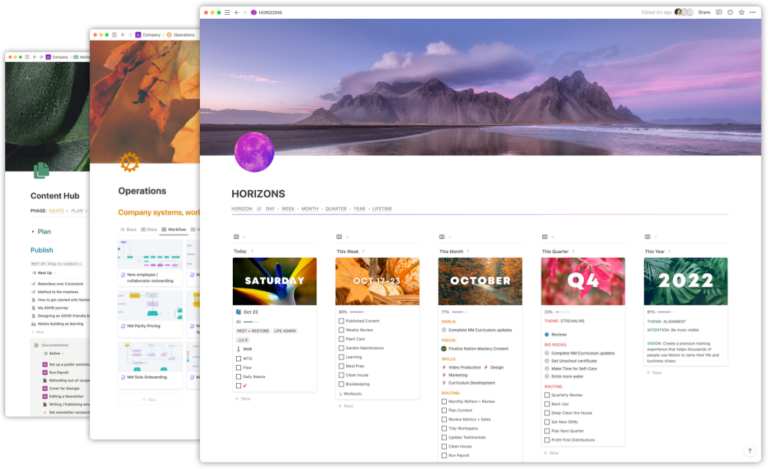Earlier this year I read Unreasonable Hospitality by Will Guidara, who has co-owned and operated 4-star, fine-dining restaurants.
This book champions always going above and beyond to over-deliver to guests, practicing what Guidara refers to as “unreasonable hospitality.” He believes that hospitality is about making a connection and says that, “every business can choose to be a hospitality business.”
Regardless of your industry, your company can deliver hospitality by taking ordinary transactions and turning them into extraordinary experiences.
We love a restaurant-related analogy for how to approach life and business; our team’s organization and workflow is influenced by Dan Charnas’ book Work Clean, which draws inspiration from the culinary principles of “mise en place.”
I wrote more about that here and Marie also recorded a YouTube video walking through her Daily Meeze process, again inspired by the principles found in Work Clean.
Unreasonable Hospitality is a book that’s been stuck in my head.
Over the last few months I have been returning to it, referencing it, and mulling over a connection I see between hospitality, experiences, and systems.
What comes to mind when you hear the word hospitality?
Maybe it’s a hotel stay, a meal out, or even a visit at a friend’s house. All of these are experiences. A sequence of moments where we are doing, seeing, and feelings things. Hospitality and experiences are about how we make people feel.
So, what makes an experience stand out?
When it makes people feel seen, heard, and cared for. Whether that’s through listening deeply, paying attention to and remembering details, going out of your way to surprise and delight, or executing something with precision. Guidara says, “people who are gifted at hospitality tend to be sensitive.” They are observant, generous, care deeply, and have a knack for picking up on what is happening around them. Folks who are skilled in those areas are adept at crafting exceptional experiences not only because of their ability to quickly tune in to how someone is feeling but also because they genuinely care to make the experience better.
Ok, so how does this connect to systems?
When you design a system you are designing an experience.
In business we have core processes (activities a customer is paying for) and support processes (activities a customer doesn’t see but which are necessary to support the core processes) and this philosophy applies to both. While the word hospitality may prompt you to think immediately of the customer, Guidara emphasizes in his book how crucial it is to consider the experiences of employees, too. He recognized that if he wanted his team to worry about how they made customers feel, he also had to be deeply invested in how he made his team feel.
When working in operations, you’re designing the experiences that both employees and clients/customers will have. Since a process generally represents an activity that will be repeated, whether it’s the check-out process a customer goes through when they buy your product, or the reporting process teammates execute at the end of a quarter, it makes sense to try to make it as enjoyable an experience as possible. Enjoyable can mean many things depending on the context of your business and whether the process is core or supporting; engaging, efficient, precise, personalized, error-free, well-documented, and generous are some words that come to mind.
When you are designing a new system, begin by setting an intention, defining not only what your desired outcome for the system is, but also how you intend folks participating in the system to feel.
Example of a support process:
- Desired outcome = to create an onboarding system for new employees
- Intention for how employees will feel = welcomed, supported, and confident they understand what is expected of them and what they can expect from us
Example of a core process:
- Desired outcome = to create a system for receiving and responding to customer feedback
- Intention for how customers will feel = acknowledged, supported, and delighted
Knowing both the desired outcome and the intention of the experience will help you design systems that are more people-centric and more likely to lead to repeat customers and engaged employees.
Excellent experiences thrive on having systems in place that make them seamless to deliver.
Amazing experiences are often the product of spontaneity and inspiration, but how do we execute that at scale?
By putting systems in place that empower your team, cultivate creativity, and make moments of inspiration easy to act on. In Unreasonable Hospitality, Guidara describes the roll of a Dreamweaver, a person whose entire job is to find ways to go above and beyond to surprise and delight people. In collaboration with other frontline employees—all whom are practicing deep listening and keen observation—this person notices the details about a customer and what they share, draws inspiration from that, and conceives and executes plans (some elaborate, some not) to somehow make their day.
Guidara emphasizes that, “the value of a gift isn’t about what went into giving it, but how the person receiving it feels.” The experiences you create (and the systems that back them up) don’t have to be lavish, but they need to be thoughtful.
How can you anticipate all the ways your team might be able to over-deliver to customers?
You probably can’t. But, what you can do is build in thoughtful systems that take you to a point and make going-the-extra-mile a little bit easier. In the case of Guidara’s team, that meant having a Dreamweaver on staff and providing them an on-site “studio” full of supplies that they could use to make their magic happen.
For your team it might look like clearly defined processes for sharing information between employees so that those in closest contact with customers can easily trade details back and forth. It might mean having certain resources on hand or contacts in your address book so it’s easy to drop a card in the mail or have a personalized gift delivered. It could be as simple as providing everyone on your customer support team a certain budget and clear parameters so they are empowered to make things right when a customer reaches out about a poor experience, without having to clear it with management.
There are many ways to surprise and delight folks, and it will all depend on the context of your business. Designing systems that enable creativity and caring and encourage your team to operate generously is a good place to start.
How does this relate to Notion (does it)?
The key to a well-functioning Notion workspace is a strong foundational system. And, as I’ve mentioned, designing a system is akin to designing an experience. Whether you’re working solo in your Notion workspace or working on a team, the way your workspace is designed will dictate the experience those using it will have.
When designing a new dashboard (or an entirely new Notion workspace) it can be helpful to answer the same questions I recommend when you’re designing a system. Ask yourself:
- What is the desired outcome? What am I trying to achieve?
- What is the intention for how people using this will feel?
One of Notion’s greatest strengths lies in its flexibility. If you know what you want to build and have an idea of what you want the user’s experience to be, the sky is really the limit to what you can create. However, that flexibility can be a blessing and a curse. If you jump into a build and haven’t clearly defined the outcome and experience, you might end up with a total mess.
Here’s an example of putting this in action in Notion:
One of my favourite use cases for Notion is team documentation.
- Desired outcome = build a database of standard operating procedures (SOP’s) that clearly state the steps to follow to execute all of our repeatable work
- Intention = team members feel empowered to take action, experience minimal context switching and distractions, and feel that executing the work is easy and enjoyable
Our documentation system has been tweaked over time. We were not as thoughtful as the above when we first started putting it together! However, over the years we have gotten increasingly clear about what we are creating, why we are creating it, and how we want the user experience to feel.
One of the major refinements we’ve implemented has been to make following the system as streamlined as possible. Some of our systems involve executing half a dozen processes, all which have their own individual entry in our documentation database. With this format it was easy for people to get distracted halfway through, or lose their place, clicking from one page to another to complete all the requirements of the system.
When we defined that we wanted folks to experience minimal context switching and distractions and to feel like executing processes was streamlined and easy, it led to some changes in how we set up documentation in our space. We started using more synced blocks and linked databases so that all the information and data required to execute a process was available on one page.
Here’s an example of all the processes that make up our event scheduling system:
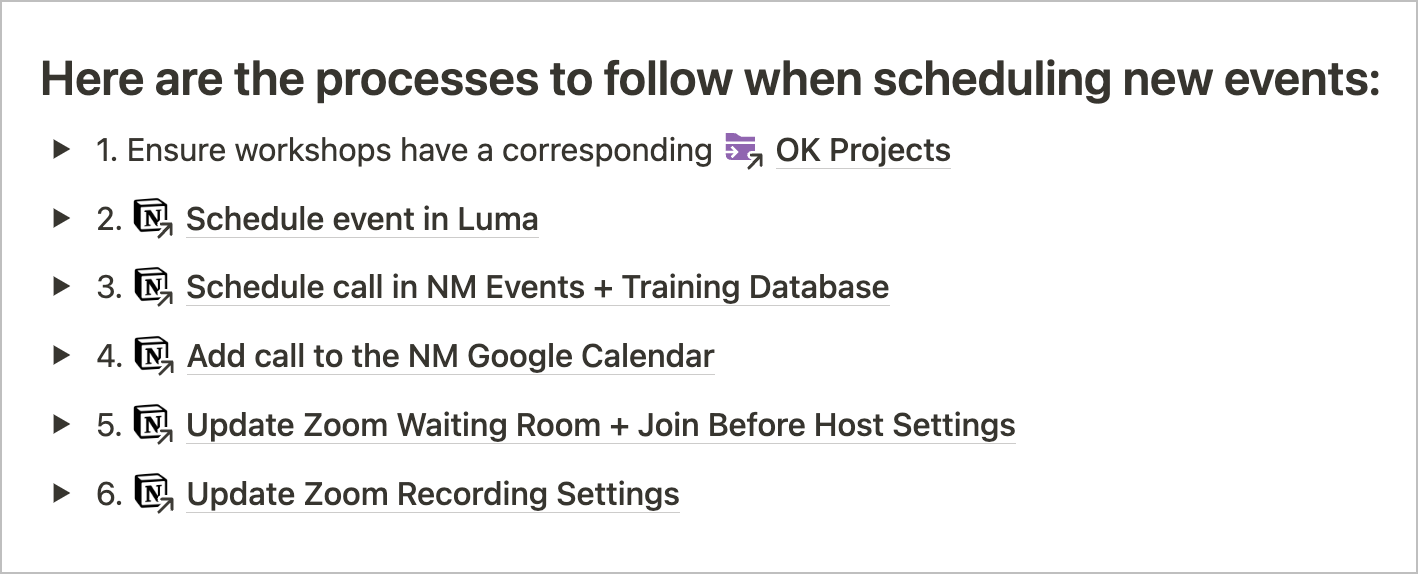
Each toggle [[ mentions that particular SOP’s page that lives in our documentation database. Within the toggle we embed a synced block (the original is on the page in the documentation database) so that the entire SOP can be accessed from this one page. And, all the SOP’s for all the other processes involved in scheduling an event can be accessed in the same way. You never have to leave this one page. But, you can also search our documentation database and easily find one singular SOP (eg. Schedule event in Luma) if you need to.
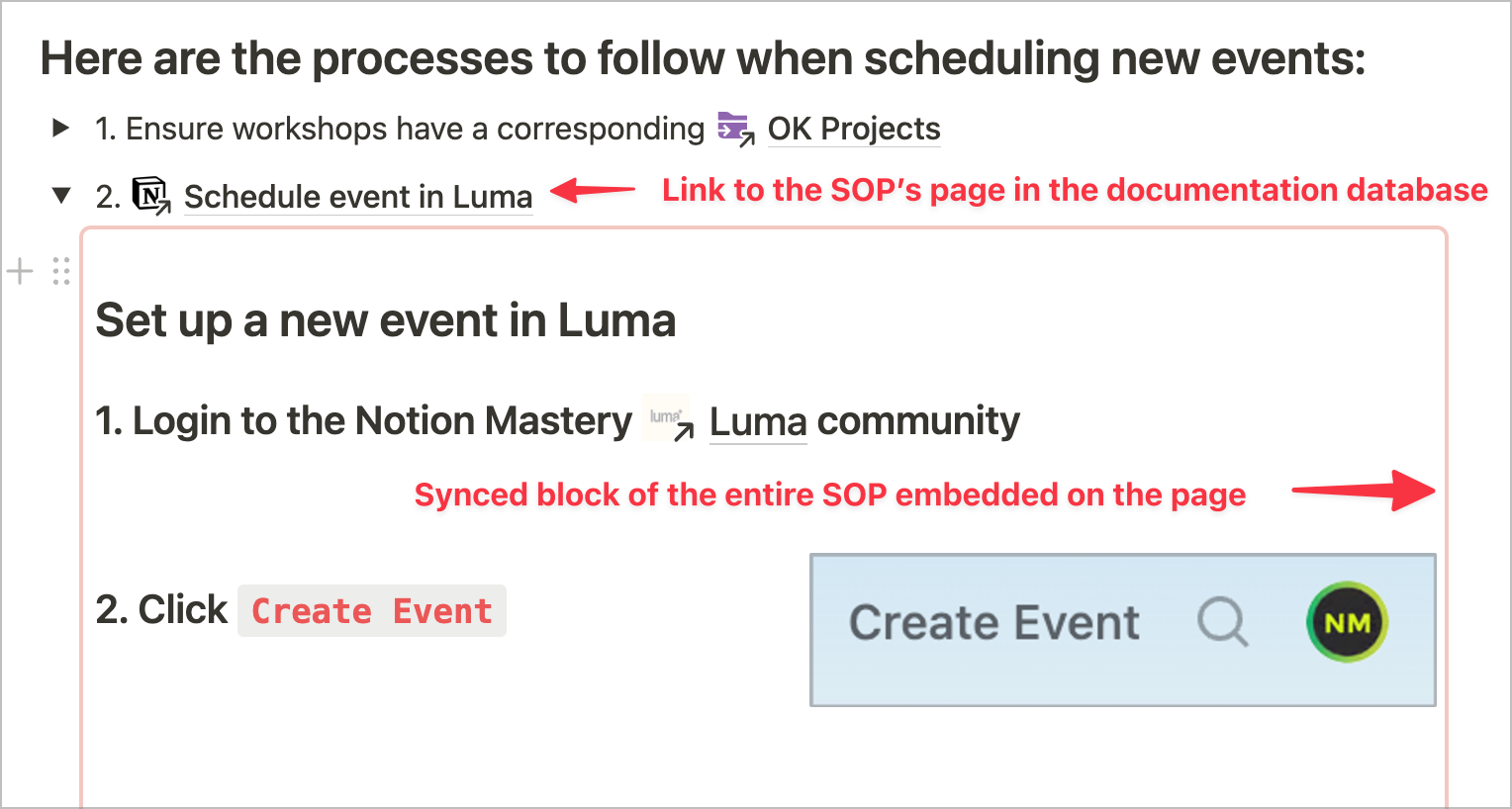
Here’s an example of our system for sharing event recordings with Notion Mastery students:
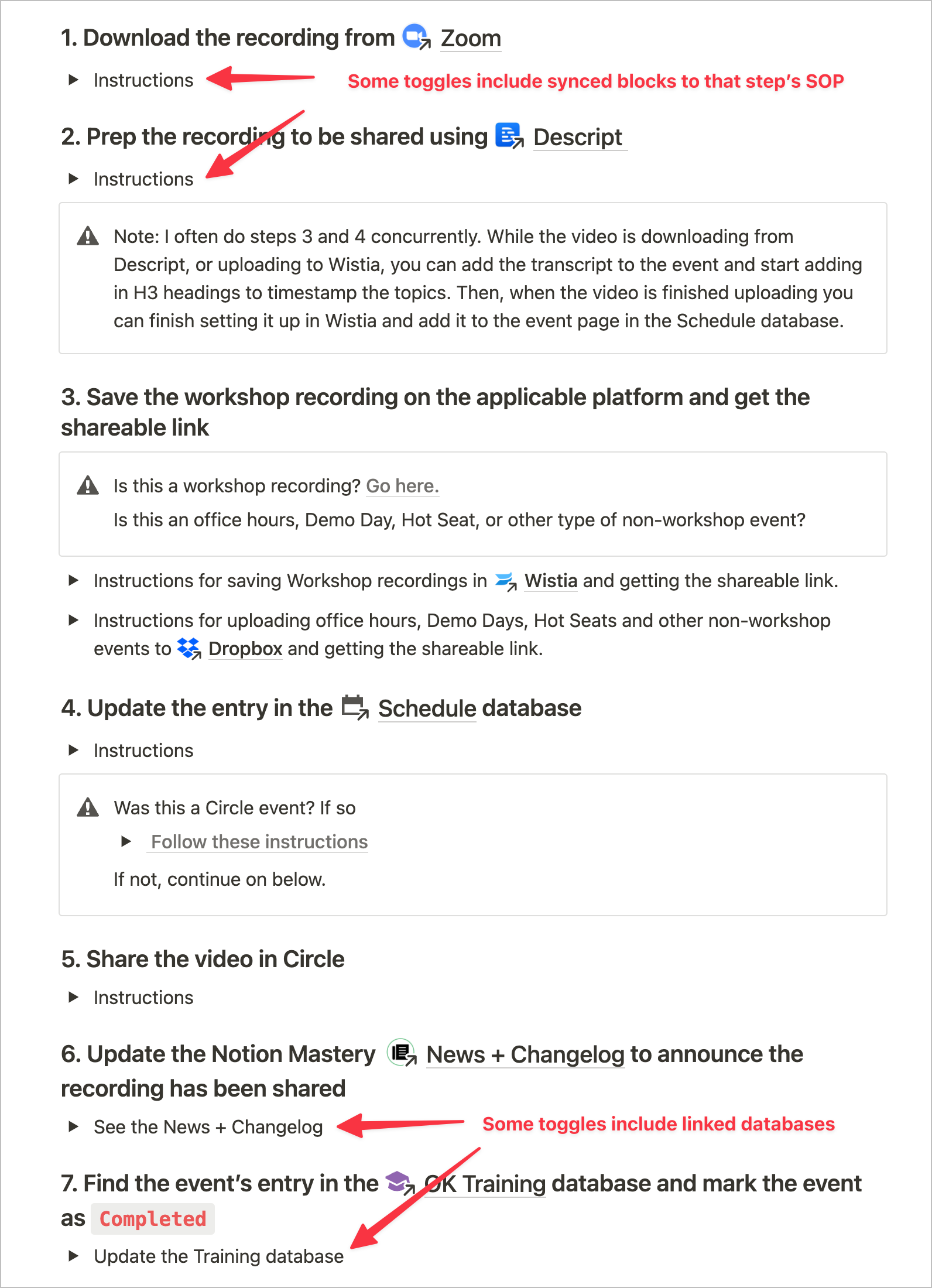
If a step of a process requires a change or addition be made to a database, we create a linked view of the database so that action can be taken immediately and from this one page. No need to click through to another page or visit the database and lose track of what you were doing.
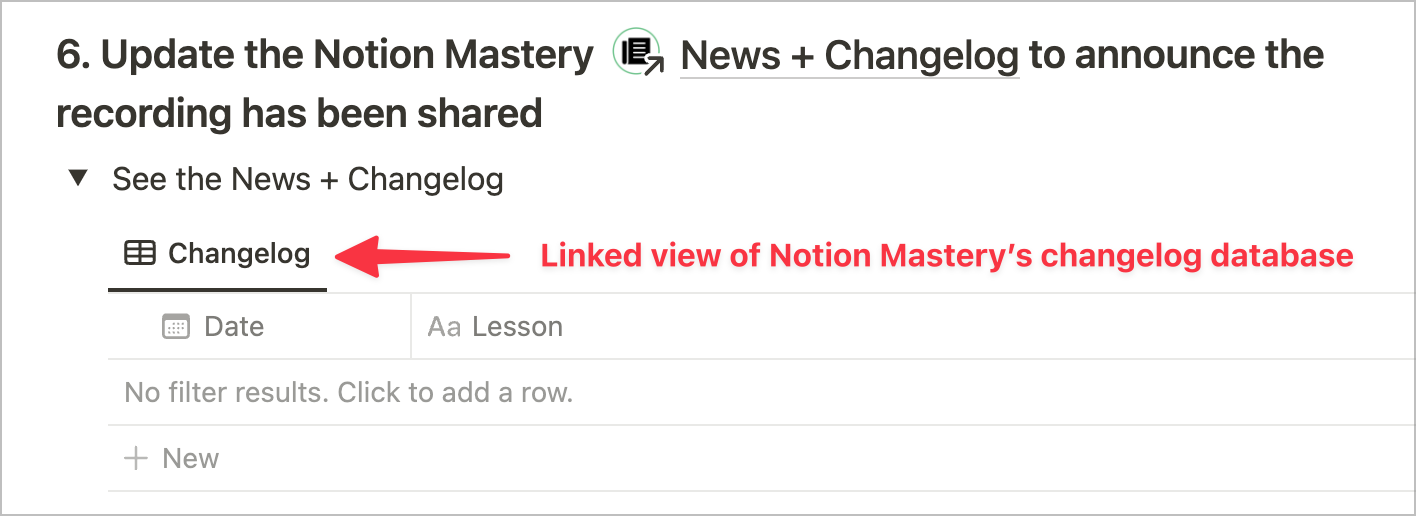
These tweaks have adjusted the experience team members have when they’re executing these processes. Refining the system has created a better experience. You can replicate this thoughtfulness across whatever tools you use to do your work, as long as you care to elevate the experiences of those around you.
I’m going to end with this:
“Even if you’re proud of the way you do something, even if it seems integral to the way you do business, that doesn’t mean you couldn’t do it better: more elegantly, more efficiently, more creatively.“
– Will Guidara, Unreasonable Hospitality
Whether you apply this philosophy to hospitality, systems, or the experiences they both create, there’s always room for refinement. The intention behind what you’re doing and the degree to which you can execute it in a way that goes above and beyond for your team and your customers will fluctuate. What will always make a difference is genuinely caring about what you create and how it inspires people to feel.

 Notion tips in your inbox
Notion tips in your inbox